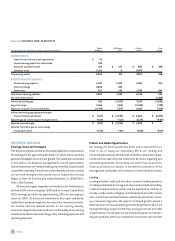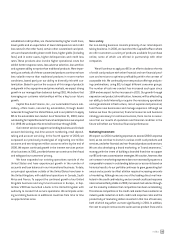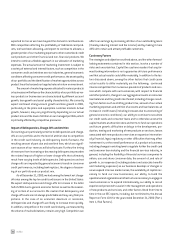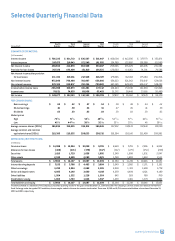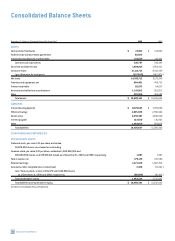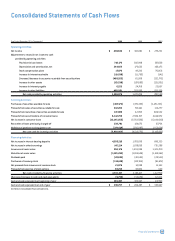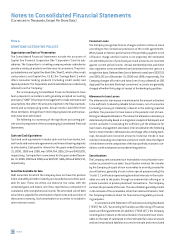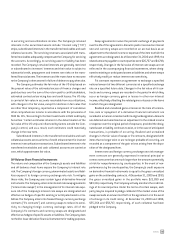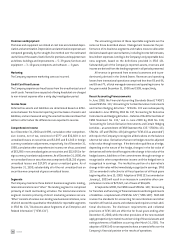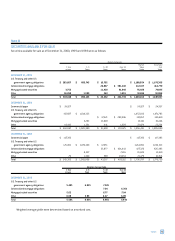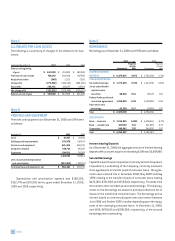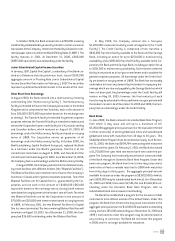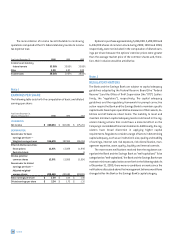Capital One 2000 Annual Report Download - page 50
Download and view the complete annual report
Please find page 50 of the 2000 Capital One annual report below. You can navigate through the pages in the report by either clicking on the pages listed below, or by using the keyword search tool below to find specific information within the annual report.
48 notes
Note A
SIGNIFICANT ACCOUNTING POLICIES
Organization and Basis of Presentation
The Consolidated Financial Statements include the accounts of
Capital One Financial Corporation (the "Corporation") and its sub-
sidiaries. The Corporation is a holding company whose subsidiaries
provide a variety of products and services to consumers. The princi-
pal subsidiaries are Capital One Bank (the "Bank"), which offers credit
card products, and Capital One, F.S.B. (the "Savings Bank"), which
offers consumer lending products (including credit cards) and
deposit products. The Corporation and its subsidiaries are collectively
referred to as the "Company."
The accompanying Consolidated Financial Statements have
been prepared in accordance with generally accepted accounting
principles ("GAAP") that require management to make estimates and
assumptions that affect the amounts reported in the financial state-
ments and accompanying notes. Actual results could differ from
these estimates. All significant intercompany balances and transac-
tions have been eliminated.
The following is a summary of the significant accounting poli-
cies used in preparation of the accompanying Consolidated Financial
Statements.
Cash and Cash Equivalents
Cash and cash equivalents includes cash and due from banks, fed-
eral funds sold and resale agreements and interest-bearing deposits
at other banks. Cash paid for interest for the years ended December
31, 2000, 1999 and 1998, was $794,764, $516,114 and $401,095,
respectively. Cash paid for income taxes for the years ended Decem-
ber 31, 2000, 1999 and 1998, was $237,217, $216,438 and $202,112,
respectively.
Securities Available for Sale
Debt securities for which the Company does not have the positive
intent and ability to hold to maturity are classified as securities avail-
able for sale. These securities are stated at fair value, with the
unrealized gains and losses, net of tax, reported as a component of
cumulative other comprehensive income. The amortized cost of debt
securities is adjusted for amortization of premiums and accretion of
discounts to maturity. Such amortization or accretion is included in
other interest income.
Consumer Loans
The Company recognizes finance charges and fee income on loans
according to the contractual provisions of the credit agreements.
When, based on historic performance of the portfolio, payment in full
of finance charge and fee income is not expected, the estimated
uncollectible portion of previously accrued amounts are reversed
against current period income. Annual membership fees and direct
loan origination costs are deferred and amortized over one year on a
straight-line basis. Deferred fees (net of deferred costs) were $237,513
and $243,172 as of December 31, 2000 and 1999, respectively. The
Company charges off credit card loans (net of any collateral) at 180
days past the due date. Bankrupt consumers’ accounts are generally
charged off within thirty days of receipt of the bankruptcy petition.
Allowance for Loan Losses
The allowance for loan losses is maintained at the amount estimated
to be sufficient to absorb probable future losses, net of recoveries
(including recovery of collateral), inherent in the existing reported
portfolio. The provision for loan losses is the periodic cost of main-
taining an adequate allowance. The amount of allowance necessary is
determined primarily based on a migration analysis of delinquent and
current accounts. In evaluating the sufficiency of the allowance for
loan losses, management also takes into consideration the following
factors: recent trends in delinquencies and charge-offs including bank-
rupt, deceased and recovered amounts; historical trends in loan
volume; forecasting uncertainties and size of credit risks; the degree
of risk inherent in the composition of the loan portfolio; economic con-
ditions; credit evaluations and underwriting policies.
Securitizations
The Company sells consumer loan receivables in securitization trans-
actions accounted for as sales. Securitization involves the transfer
by the Company of a pool of loan receivables to an entity created for
securitizations, generally a trust or other special purpose entity (the
"trusts"). Certificates representing beneficial interests in the receiv-
ables are sold to the public through an underwritten offering or to
private investors in private placement transactions. The Company
receives the proceeds of the sale. The securitization generally results
in the removal of the receivables, other than retained interests, from
the Company’s balance sheet for financial and regulatory account-
ing purposes.
In accordance with Statement of Financial Accounting Standards
("SFAS") No. 125, "Accounting for Transfers and Servicing of Financial
Assets and Extinguishments of Liabilities" ("SFAS 125"), the Company
records gains or losses on the securitization of consumer loan receiv-
ables on the date of sale based on the estimated fair value of assets
sold and retained and liabilities incurred in the sale and are included
Notes to Consolidated Financial Statements
(Currencies in Thousands, Except Per Share Data)


